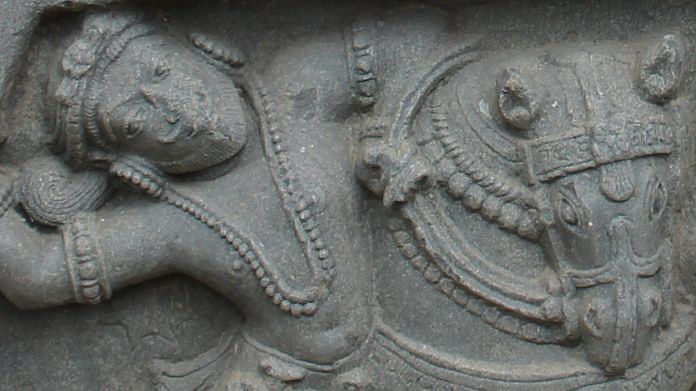Contrary to what we might imagine, the 13th century was a time of global arms deals, deterrents, escalations, and grand strategic manoeuvres, quite similar to those of today. Among the premier weapons of that time were warhorses from Central and West Asia. Carefully bred, trained, and exported through networks spanning thousands of kilometres, their lives were short and brutal. By examining the dynamics of which these animals were a part, we can catch a glimpse of a complex, innovative medieval world and understand our own better.
The global trade in warhorses
Over the course of the early 1200s, the Mongol people had created an empire unlike any in human history. Their dominion stretched across a vast swathe of Eurasia — from Russia to Iran to China — and it reshaped networks of trade and exchange, allowing unprecedented degrees of interaction between these regions. Iran and China, the two cornerstones of this Mongol world, became especially interconnected through overseas trade. Ships to and from these regions passed by India, pausing to trade seasonally along its western and southern coasts.
Although we have a habit of thinking of India as somehow disconnected or aloof from global developments, the truth is that just like today, the subcontinent responded to and drove transformations in the 13th-century world too. The highly militaristic polities of the peninsula immediately grasped the advantages of increasing trade with the Mongol-ruled polities, especially due to their connections with horse-breeders in Central Asia. Merchants, especially of the Kudirai Chetti and the Hedabuka castes, made fortunes as horse traders; they are attested as actively participating in annual auctions in Yemen, paying in gold and silk to secure hundreds of fine warhorses.
During his travels in the 1270s, Venetian trader Marco Polo noted that the Seuna Yadava dynasty of present-day Maharashtra was so desperate for warhorses that it connived with pirates to seize merchants’ shipments of animals. On the other hand, the Kakatiya dynasty of present-day Telangana attempted to woo horse dealers from across the Indian Ocean region. In a 1244 inscription, king Ganapati Deva declared that whereas previous kings had seized all goods (especially horses) lost in shipwrecks, he would generously return them to the merchants, asking for only customs fees. This seems to have had the intended effect: Professor Ranabir Chakravarti has written that horses were brought to Kakatiya territories from as far away as Iran, Bhutan, Yunnan, and the Tibetan Plateau.
Even more ambitious in its horse imports was the Pandya dynasty of present-day Tamil Nadu — historian Elizabeth Lambourn writes that in the 1290s, an important Mongol family served as their advisors and chief procurers both at Tamil and Iranian ports, delivering thousands of horses for the Pandya cavalry and setting the prices in horse-markets stretching from Hormuz to Kayilpattinam. As much as 220 dinars of red gold were spent on a single animal, and the full price was paid irrespective of whether it was alive or dead upon delivery, suggesting that the Pandyas were attempting to secure a monopoly on horses for use in military campaigns against other major dynasties.
Also read: Indian history without the Deccan is like European history minus France
Arms monopolies and grand strategy
Ultimately, however, it was not economic muscle but effective tactics and grand strategy that allowed an Indian power to monopolise the imported warhorse. When the Delhi Sultanate was faced with the challenge of Mongol expansion in the 1290s, it sought to cost-effectively secure vast quantities of the animals through wars with the kingdoms of the peninsula. Military historians Simon Digby and Jean Deloche argue that the Pandyas, Kakatiyas and other powers were very much on par with the Sultanate technologically; the latter only differed from them in terms of the use of cavalry archers.
Thus, through multiple campaigns in the early 1300s, then-Delhi General Malik Kafur bolstered this slight tactical edge with the use of subterfuge and local intelligence. He struck when the kingdoms were least expecting him, directly besieging their capitals rather than confronting them through field engagements. He then demanded thousands of horses in tribute from the Yadavas, Kakatiyas, and Pandyas while also plundering some wealthy temples; this made it financially impossible for them to maintain the cavalry forces that were crucial for their internal and external conflicts and led to their collapse. Delhi, strengthened with vast quantities of warhorses, was thus able to defeat the Mongols and dominate the Deccan, though it proved unable to maintain the strategic monopoly in the long term and was soon driven out by new states such as Vijayanagara and the Bahmani Sultanate.
Medieval South Indians’ overreliance on international trade and high-budget expenditure to secure military resources was clearly faulty, but perhaps there are lessons to be learned from how the Delhi Sultanate sought to establish strategic monopolies. As all this should show us, the medieval world is not some obscure and irrelevant place, but rather one that can and should be objectively studied to put our own challenges into perspective.
Anirudh Kanisetti is a writer and digital public humanities scholar. He is author of Lords of the Deccan, a new history of medieval South India, and hosts the Echoes of India and Yuddha podcasts. Views are personal.
This article is a part of the ‘Thinking Medieval‘ series that takes a deep dive into India’s medieval culture, politics, and history.
(Edited by Humra Laeeq)



